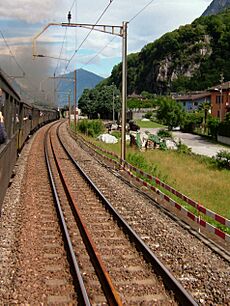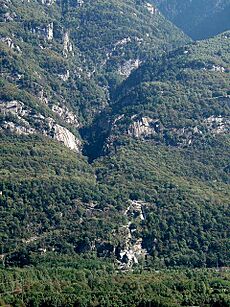Cresciano facts for kids
Quick facts for kids
Cresciano
|
||
|---|---|---|
|
||
| Country | Switzerland | |
| Canton | Ticino | |
| District | Riviera | |
| Area | ||
| • Total | 17.23 km2 (6.65 sq mi) | |
| Elevation | 260 m (850 ft) | |
| Population
(December 2004)
|
||
| • Total | 593 | |
| • Density | 34.42/km2 (89.14/sq mi) | |
| Postal code |
6705
|
|
| Surrounded by | Arvigo (GR), Claro, Lodrino, Moleno, Osogna, Preonzo, San Vittore (GR) | |
Cresciano was once a municipality (a type of town) in the Riviera area of the canton of Ticino in Switzerland.
On April 2, 2017, Cresciano joined with the towns of Iragna, Lodrino, and Osogna. They all became part of a new, larger municipality called Riviera.
Contents
History of Cresciano
Cresciano was first written about in the year 1269. Back then, it was called Crazano.
During the 1800s, when the Gotthard railway was being built, people found signs of a very old settlement. This settlement was from the Bronze Age, a time thousands of years ago.
In 978, an important document from the Holy Roman Empire (a large kingdom in Europe) mentioned a place called cortis Crissianicum. This place belonged to a monastery (a religious building) in Pavia, Italy. Like other nearby towns, Cresciano was later owned by the Cathedral of Milan.
In the 1300s, Cresciano, along with Osogna and Claro, was put under the rule of a leader from the Visconti family. In the 1400s, the city of Milan gave Cresciano the right to choose its own community leader.
The local church, called San Vincenzo, has been around since the 1200s.
Around 1880, quarries (places where stone is dug out) for granite opened in the valley. These quarries became very important for the economy of Cresciano and its nearby towns.
Cresciano's Geography
Cresciano covers an area of about 17.23 square kilometers (6.65 square miles).
Here's how the land is used:
- About 4.5% is used for farming.
- A large part, about 58%, is covered by forests.
- Around 3% has buildings and roads.
- About 2% is made up of rivers or lakes.
- The remaining 30.5% is land that can't be used for farming or building, like rocky areas.
Most of the water in the area comes from flowing rivers.
Cresciano's Coat of Arms
The blazon (a special description) of Cresciano's coat of arms is: Per fess azure an arch of stone blocks, a sledge hammer, and a chisel in saltire all argent and gules seven bendlets argent. This describes the symbols and colors on the town's shield.
People of Cresciano (Demographics)
In 2008, about 31.3% of the people living in Cresciano were foreign nationals. Over ten years (1997–2007), the number of people living there grew by 5.9%.
Most people in Cresciano speak Italian (about 83.6%). German is the second most common language (5.3%), followed by Portuguese (5.1%). A few people also speak French or Romansh.
In 2008, there were slightly more men (51.6%) than women (48.4%) living in Cresciano. About 35.4% of the people living in Cresciano in 2000 were born there. Another 28.1% were born in the same canton (Ticino).
The population changes each year due to births, deaths, and people moving in or out. In 2008, the number of Swiss citizens living in Cresciano went down a little, while the number of non-Swiss people went up.
Here's a look at the age groups in Cresciano in 2009:
- Children (0-9 years old): 7.2%
- Teenagers (10-19 years old): 8.8%
- Young adults (20-29 years old): 13.6%
- Adults (30-59 years old): 47.1%
- Seniors (60 years and older): 23.4%
In 2000, there were 255 households in Cresciano, with about 2.3 people living in each home. About 32.4% of households had only one person.
Most of the buildings in Cresciano are single-family homes (70.5%). Many of these were built between 1919 and 1945. In 2000, there were 300 apartments in the town. Most of them had 4 rooms. About 84% of these apartments were lived in all the time.
The chart below shows how the population of Cresciano has changed over many years:

Cresciano's Economy
In 2007, the unemployment rate in Cresciano was 5.99%.
In 2005, people worked in different types of jobs:
- Primary sector: 12 people worked in jobs like farming. There were 4 businesses in this area.
- Secondary sector: 58 people worked in jobs like manufacturing or construction. There were 7 businesses in this area.
- Tertiary sector: 49 people worked in jobs like sales, hotels, or education. There were 13 businesses in this area.
In 2008, there were 105 full-time jobs in Cresciano. Most of these jobs were in mining and construction.
Many people who live in Cresciano travel to other towns for work. In 2000, 174 people left Cresciano for work, while 98 people came into Cresciano for work. Most people (76.6%) used a private car to get to work.
Religion in Cresciano
According to the 2000 census, most people in Cresciano (81.1%) were Roman Catholic. About 3.7% belonged to the Swiss Reformed Church. There were also smaller groups of people who were Orthodox Christians, Christian Catholics, or belonged to other Christian churches. A small number of people (0.85%) were Islamic. About 5.62% of the population did not belong to any church.
Education in Cresciano
In Cresciano, about 39.5% of the people have finished high school (upper secondary education). About 3.7% have gone on to higher education, like a university.
In 2009, there were 94 students in Cresciano.
- Kindergarten: 15 children were in kindergarten, which is not required but helps prepare kids for school.
- Primary School: 16 students were in regular primary school, and 4 were in a special primary school. Primary school lasts for five years.
- Lower Secondary School: Students either go to a two-year middle school (30 students) or a four-year program (9 students) that gets them ready for higher education.
- Upper Secondary School: This level prepares students for a job or for university.
- 7 students were in full-time vocational training (learning a trade).
- 10 students were in part-time vocational training.
- Professional Program: 3 students were in a three-year program that prepares them for jobs in fields like engineering or nursing.
In 2000, 2 students from other towns came to Cresciano for school. However, 44 students from Cresciano went to schools outside the town.
See also
 In Spanish: Cresciano para niños
In Spanish: Cresciano para niños







